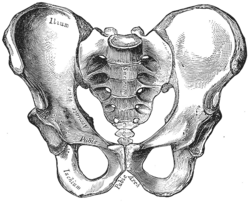Pubic bone
| Pubic of pelvis | |
|---|---|

Pelvic girdle
|
|

Male pelvis
|
|
| Details | |
| Identifiers | |
| Latin | Os pubis |
| MeSH | A02.835.232.611.781 |
| TA | A02.5.01.301 |
| FMA | 16595 |
|
Anatomical terms of bone
[]
|
|
In vertebrates, the pubic bone is the ventral and anterior of the three principal bones composing either half of the pelvis.
It is covered by a layer of fat, which is covered by the mons pubis.
It is divisible into a body, a superior ramus and an inferior ramus.
In the female, the pubic bone is anterior to the urethral sponge.
The left and right hip bones join at the pubic symphysis.
The pubis is the lower limit of the suprapubic region.
The body forms one-fifth of the acetabulum, contributing by its external surface both to the lunate surface and the acetabular fossa. Its internal surface enters into the formation of the wall of the lesser pelvis and gives origin to a portion of the obturator internus.
The clade Dinosauria is divided into the Saurischia and Ornithischia based on hip structure, including importantly that of the pubis. An "opisthopubic" pelvis is a condition where the pubic bone extends back towards the tail of the animal, a trait that is also present in birds. In a "propubic" pelvis, however, the pubic bone extends forward towards the head of the animal, as can be seen in the Saurischian pelvic structure pictured below. The acetabulum, which can be thought of as a "hip-socket", is an opening on each side of the pelvic girdle formed where the ischium, ilium, and pubis all meet, and into which the head of the femur inserts. The orientation and position of the acetabulum is one of the main morphological traits that caused dinosaurs to walk in an upright posture with their legs directly underneath their bodies. The prepubic process is a bony extension of the pubis that extends forward from the hip socket and toward the front of the animal. This adaptation is thought to have played a role in supporting the abdominal muscles.
...
Wikipedia
